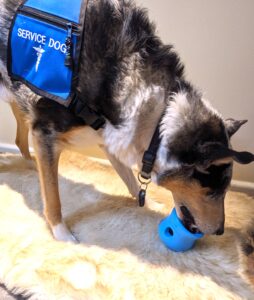Retiring a service dog is an emotional topic for service dog handlers. Trainers can make a big difference in preparing and supporting handlers and their partners through this transition.
Assessing the Right Time to Retire
Most service dogs work alongside their handlers until they’re between 8 and 10 years old. However, every dog is unique. Some dogs, due to their good health, may continue working for much longer, while others might face unexpected health challenges that call for an early retirement. The signs may be clear: changes in behavior, a dip in performance or the emergence of health issues. However, sometimes, the signs are more subtle. This can be tricky for handlers who may not notice deterioration in the dog’s performance or health over time due to their daily interactions with the dog. Trainers, by staying in close touch with handlers and consulting veterinarians, can provide guidance in making this tough decision.
Planning Ahead for Retirement
It’s important to think about what retirement will look like for the dog long before the end of their working days. In many instances, handlers will continue to care for the dog after retirement. For those where the dog will remain with the handler, there might be added challenges, such as ensuring a handler with a mobility disability can care for an aging dog that develops their own mobility issues due to conditions like joint pain. In some cases, dogs may have expensive medical needs. This can be especially difficult for people with disabilities who are on a limited or fixed income. Trainers can provide guidance, troubleshooting support and resources that may be helpful.
In some cases, it may not be feasible for the service dog handler to care for the dog during retirement. Service dog programs may make arrangements to return the dog to their puppy raiser or transition to another loving home. For dogs moving to new surroundings, it’s beneficial to familiarize them with their new environment gradually – perhaps through scheduled visits or even short stays. This way, when retirement does come, the dog has developed a positive relationship with their new caregivers.
Transitioning to a New Service Dog
When handlers decide to introduce a new service dog, the dynamics of managing a multi-dog household come into play. Trainers can help handlers smoothly integrate the new addition. This can include ensuring the senior dog gets quiet breaks away from a lively puppy, providing education on what appropriate play interactions look like and supporting handlers through the various issues that can arise in a multiple-dog household.

It’s not uncommon for handlers to share that they feel guilty when they head out with a new service dog, leaving their retired partner at home. A useful strategy is occasionally leaving the dog at home even before retirement begins, finding other ways to mitigate disability needs. This not only prevents potential separation issues but also makes the experience of staying home less jarring for both handler and dog. Trainers can suggest ways to provide additional enrichment for the retired service dog – such as with sniff-and-explore walks, engaging puzzle toys and trick training.
Retiring a service dog is never easy for the team, but with foresight and the support of dedicated trainers, both service dogs and their partners can transition with grace and care.
